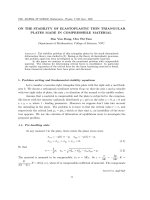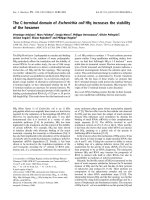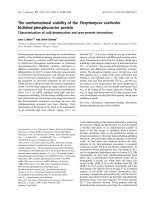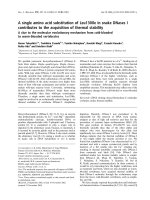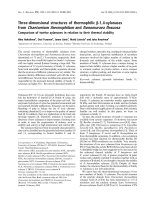Thermal Stability of RNA Phage Virus-Like Particles Displaying Foreign Peptides potx
Bạn đang xem bản rút gọn của tài liệu. Xem và tải ngay bản đầy đủ của tài liệu tại đây (1.16 MB, 7 trang )
RESEARC H Open Access
Thermal Stability of RNA Phage Virus-Like
Particles Displaying Foreign Peptides
Jerri C Caldeira and David S Peabody
*
Abstract
Background: To be use ful for genetic display of foreign peptides a viral coat protein must tolerate peptide
insertions without major disruption of subunit folding and capsid assembly. The folding of the coat protein of RNA
phage MS2 does not normally tolerate insertions in its AB-loop, but an engineered single-chain dimer readily
accepts them as long as they are restricted to one of its two halves.
Results: Here we characterize the effects of peptide insertions on the thermal stabilities of MS2 virus-like particles
(VLPs) displaying a variety of different peptides in one AB-loop of the coat protein single-chain dimer. These
particles typically denature at temperatures around 5-10°C lower than unmodified VLPs. Even so, they are generally
stable up to about 50°C. VLPs of the related RNA phage PP7 are cross-linked with intersubunit disulfide bonds and
are therefore significantly more stable. An AB-loop insertion also reduces the stability of PP7 VLPs, but they only
begin to denature above about 70°C.
Conclusions: VLPs assembled from MS2 single-chain dimer coat proteins with peptide insertions in one of their
AB-loops are somewhat less stable than the wild-type particle, but still resist heating up to about 50°C. Because
they possess disulfide cross-links, PP7-derived VLPs provide an alternate platform with even higher stability.
Background
We recently described a method for peptide presentation
on virus-like particles (VLPs) of the RNA bacteriophage
MS2, which we believe offers several advantages over
other display sys tems for certain applications [1-3]. Pep-
tides are inserted by recombina nt DNA methods into a
surface loop of coat protein. When expressed from a plas-
mid in bacteria, the resulting VLPs display the foreign
peptides on their surfaces. Each VLP also encapsidates the
mRNA encoding its synthesis, thus enabling recovery of
affinity-selected sequences from random sequence libraries
by reverse transcription and polymerase chain reaction
[2-4]. Like the fil amentous phage display technique, MS2
VLP display should be useful for the affinity selection of
peptides with binding activity for a wide variety of receptor
molecules (e.g. antibodies). Unlike filamentous phages,
however, MS2 VLPs readily display foreign peptides at
such high densities that they are strongly immunogenic.
We are exploiting this capability to develop a vaccine
discovery technology in which a single particle serves both
for epitope identification and immunization [2,4]. The
ability to present affinity-selected peptides to the immune
system in the same structural context present during their
affinity selection may facilitate the isolation of mimotopes
able to elicit a desired antibody response [5,6].
Efficient peptide display on the MS2 VLP depends on
the tolerance of coat protein folding and stability to
insertions in its AB-loop. Unfortunately wild-type coat
protein is poorly tolerant of such insertions, the vast
majority giving rise to mis-folded, aggregated or degraded
proteins [2]. However, taking note of the physical proxi-
mity in the dimer of the C-terminus of one polypeptide
chain to the N-terminus of its companion chain, we
genetically fused the two subunits to form a so-called sin-
gle-chain dim er [7]. The genetic fusion of subunits in the
single-chain dimer suppresses the defects imparted by
AB-loop insertions, as long as they are confined to one
half of the dimer, allowing the protein to fold correctly
and then assemble into the VLP [1,2]. This is due pre -
sumably to the increased thermodynamic stability of the
single-chain dimer compared to the wild-type protein.
* Correspondence:
Department of Molecular Genetics and Microbiology, University of New
Mexico School of Medicine, and Cancer Research and Treatment Center,
Albuquerque, New Mexico, 87131, USA
Caldeira and Peabody Journal of Nanobiotechnology 2011, 9:22
/>© 2011 Caldeira and Peabody; licensee BioMed Central Ltd. This is an Open Access article distributed under the terms of the Creative
Commons Attribution License ( which permits unrestricted use, distribution, and
reproduction in any medium, provided the original work is properly cited.
We were curious to know whether the peptide insertions
alter the stability of the VLP itself.
Results
The b acteriophage MS2 coat protein is the major struc-
tural protein of the virus and when expressed from a
plas mid in E. coli it self-assembles into VLPs whose shell
structure is virtually identical to that of the MS2 virion.
The so-called AB-loop resides on the surface of the VLP
and repre sents a logical site for peptide insertion and dis-
play. We previously demonstrated that insertions here
generally disrupt coat protein folding/stability, but that
genetic fusion of the two dimer subunits suppresses these
defects when the insertion is present in the AB-loop of
the downstream half of the single-chain dimer [2]. The
recombinants described in this paper were created by
insertion of several specific foreign peptides, as well as a
library of random-sequence peptides, to produce the con-
structs shown in Figures 1, 2 and 3. VLPs were expressed
in E. coli and purified by methods detailed previously [8].
The denaturation profiles for MS2 wild-type and sin-
gle-chain dimer VLPs (without an inserted peptide) are
plotted in F igure 4a. Note that the values shown in
Figure 4 are the averages of two inde pendent measure-
ments. For simplicity, error bars are not shown in the
graphs, but the results were highly reproducible, the
standard deviations never exceeding a few percent. Of
course, it was possible that VLP disassembly might
occur at lower temperatures than protein precipitation.
To determine the correspondence of the two processes,
an aliquot of each of the soluble fractions was subjected
to electrophoresis on agarose gel to determine the
amount of VLP remaining at each temperature. The
coincidence of the curves showing the disappearance of
the VLP band from gels, and of coat protein from the
soluble fraction suggests that disassembly and denatura-
tion/precipitation are r oughly concomitant processes
(Figure 4A).
Figure 4B shows the denaturation profiles for wild-type
VLPs, single-chain dimer VLPs, and of several VLPs made
from single-chain dimers with several specific peptide
insertions in their second AB-loops. Under these condi-
tions, wild-type VLPs are half-denatured at about 68°C,
while single-chain dimer VLPs (lacking peptide insertions)
are slightly less stable, with half-denaturation occurring at
around 64°C. The peptide-displaying single-chain dimer
W
dϳ
<ƉŶ/^Ăů/ Ăŵ,/
Ɖ^Wϭ
W
dϳ
<ƉŶ/
Ăŵ,/
ƉdϮWϳ<ϯϮ
Figure 1 The plasmids and peptide insertions utilized in this
study. (A) pDSP1 expresses the MS2 coat protein single-chain
dimer from the T7 promoter. The manipulations that resulted in the
various peptide insertions utilized Sal I and Kpn I sites uniquely
present in the downstream half of the dimer. The plasmid
pET2P7K32 is a similar construction that expresses the PP7 single-
chain dimer.
M
S
2 coat
10 11 12 13 14 15 16 17 18 19
…ValAspAsnGlyGlyThrGlyAspValThr…
…GTCGAC
AATGGCGGTACCGGCGACGTGACT…
ECL2-15/14
…13 14 15 14 15 16 …
…GlyGlyThrArgSerGlnArgGluGlyLeuHisTyrThrGlyThrGly…
…GGCGGTACTCGCAGCCAGCGCGAAGGCTTGCATTATACCGGTACC
GGC…
V3-15/14
…13 14 15 14 15 16 …
…GlyGlyThrIleGlnArgGlyProGlyArgAlaPheValGlyThrGly…
…GGCCGTACTATTCAGCGCGGCCCGGGCCGCGCGTTTGTGGGTACC
GGC…
F-13/16
…10 11 12 13 16 17 18 19 …
…ValAspAsnGlyAspTyrLysAspAspAspAspLysGlyAspValThr…
…GTCGAC
AATGGCGACTACAAGGACGACGACGACAAGGGCGACGTGACT…
F-13/14
…10 11 12 13 14 15 16 17 …
…ValAspAsnGlyAspTyrLysAspAspAspAspLysGlyThrGlyAsp…
…GTCGAC
AATGGCGACTACAAGGACGACGACGACAAGGGAACTGGCGAC…
(NNS)
10
-13/16
…10 11 12 13 16 17 18 19 20 …
…ValAspAsnGly X
10
GlyAspValThrVal…
…GTCGAC
AATGGC(NNS)
1
0
GGCGACGTGACTGTC…
Figure 2 The amino acid and nucleotide sequences of MS2
coat protein in the vicinity of the various peptide insertions.
Note the positions of Kpn I and Sal I sites (underlined).
Wild
-type
PP
7
… 7 8 9 10 11 12 13 14 15 16 17 18 …
…LeuSerValGlyGluAlaThrArgThrLeuThrGlu…
…CTTTCGGTCGGCGAGGCTACTCGCACTCTGACTGAG…
KpnI mutant PP7
… 7 8 9 10 11 12 13 14 15 16 17 18 …
…LeuSerValGlyThrAlaThrArgThrLeuThrGlu…
…CTTTCGGTCGGTACC
GCTACTCGCACTCTGACTGAG…
F-2PP7
…10 11 11 12 13 …
…GlyThrAspTyrLysAspAspAspAspLysGluAlaThr…
…GGTACC
GATTATAAAGATGATGATGATAAAGAGGCTACT
…
Figure 3 PP7 sequences, showing the wild-type, the Kpn I
mutant and the Flag peptide insertion. Note that the mutations
that introduce a Kpn I site in the AB-loop and also substitute Glu11
with Thru.
Caldeira and Peabody Journal of Nanobiotechnology 2011, 9:22
/>Page 2 of 7
VLPs show reduced stability compared to VLPs lacking
the peptides. Both versions of the Flag VLP, for example,
show half-denaturation at around 53°C. Small differences
in the Flag peptide insertion site (Figure 2) do not appreci-
ably alter VLP stability, since F-13 /14 and F-13/16 show
identical be haviors. The V3 VLP denatures at around
55°C, while the stability of the ECL2 recombinant, at
about 57°C, is nearest to that of the parental particle. Thus
these AB-loop insertions destabilize the VLP by between 5
and 10°C in this assay. Even so, the particles still possess
relatively stable structures that are disrupted only above
50°C.
We determined the time course of VLP denaturation
by incubating them for various times at a fixed tempera-
ture of 55°C (Figure 4C). Both MS2 phage and wild-type
VLPs show slow denaturation at this temperature, losing
only about 10% of native protein over the 40 minutes of
the experiment. The single-chain dimer VLP is some-
what less stable, with about 60% of the VLP surviving
40. However, the peptide-displaying VLPs denature
more rapidly, only 5-20% remaining at the 5-minute
time point. This is consistent roughly wit h the results of
the denaturation curves of Figure 4A, since 55°C is close
to the melting transitions for each of the recombinant
VLPs.
To test the stability effects of peptides generally, we
created a complex random-sequence peptide library by
insertion of ten NNS triplets between codons for amino
acids 13 and 16 in the MS2 AB loop. The denaturation
profile of the random 10-mer library (~10
9
individual
A. B.
C.
Figure 4 Denaturation of MS2 VLPs. (A) Coincidence of VLP disassembly, as determined by loss of the VLP band on an agarose gel, and coat
protein denaturation, determined by disappearance of soluble protein as a function of temperature. “MS2 WT” denotes the wild-type coat
protein, while “MS2 sc-dimer” refers to the MS2 coat protein single-chain dimer. “Soluble” indicates whether the data points were obtained by
measuring the amount of soluble protein remaining after treatment and “VLP” identifies data points showing the quantity of intact VLP. (B)
Denaturation of various recombinant VLPs as a function of temperature. “F13/14” and “F13/16” refer to VLPs displaying the Flag epitope at two
different locations in the AB-loop (see the text). “ECL2” and “V3” refer to VLPs displaying the extracellular loop 2 of CCR5 and the V3 loop of the
HIV envelope protein, respectively. “Random 10mer” identifies results obtained using a complex library of random-sequence 10mer insertions. (C)
Denaturation of the indicated MS2 VLPs as a function of time at 55°C.
Caldeira and Peabody Journal of Nanobiotechnology 2011, 9:22
/>Page 3 of 7
members) is also shown in Figure 4B. The behavior is
similar to that shown by the individual recombinants
described earlier, with about half the protein precipitat-
ing at around 55°C. Here, of course, we are following
the a verage behavior of a highly complex population of
VLPs, but it is consistent with the range of behaviors
observed for VLPs displaying specific peptides. It should
be noted that coat proteins lacking insertions represent
about 5-10% of the library population, and probably
account for the existence of a second species denaturing
at higher temperature. Of course the effects of indivi-
dual peptide insertions could vary over a wide range
and it is even seems possible that some the random
sequence peptides have little effect, or may even stabi-
lize the VLP.
A PP7 recombinant is more stable
We have recently created a system for peptide display on
PP7 VLPs similar to the one based on MS2 we described
previously [2,3]. As with MS2, we introduced a Kpn I site
into the PP7 AB-loop-encoding sequence by site-directed
mutagenesis. This converted the glutamic acid normally
present at position 11 to threonine, but resulted in no
apparent alteration of the structure or function of PP7
coat protein as assessed by its translational repressor activ-
ity or b y its ability to assemble into a VLP (not shown).
We constructed a peptide-displaying version of PP7 by
inserting the Flag sequence as illustrated in Figure 3.
We showed previously and in Figure 5A, that single-
chain dimer PP7 VLPs (without a peptide insertion) are
significantly more stable than those of MS2, owing to the
presence of inter-dimer disulfide bonds [9]. With the disul-
fides intact the curves for single-chain VLP disassembly
and protein precipitation were roughly coincident, with
denaturation and disassembly occurring together a bove
about 85°C. In the presence of DTT, however, we observed
a drastic reduction in the temperature at which the VLP
disassembled. In fact, when the disufldes were broken it
was no more stable than the MS2 single-chain VLP of
Figure 4A. However, the PP7 single-chain protein was
more resistant to precipitation, so that the curves for VLP
disassembly and protein precipitation were not coincident.
These results, obtained earlier, are shown for comparison
with the results for the Flag-2PP7 recombinant VLPs
(Figure 5B). Again the experiment was conducted in both
the presence and absence of DTT, and the Flag-2PP7 VLP
was assayed for particle disassembly by gel electrophoresis,
as well as for protein precipitation. In the absence of DTT,
the peptide insertion caused a reduction in VLP stability;
the Fl ag-2PP7 VLP dena turat ion temperature is roughly
10°C lower than that of its insertion-less counterpart. The
curves for protein precipitation and VLP disassembly are
similar, indicating that with its disulfide bonds intact, cap-
sid disassembly and protein precipitation occur together.
Note also that the Flag-2PP7 recombinant is significantly
more stable than the MS2 equivalent, beginning to den a-
ture only at temperatures above about 70°C. When DTT is
added to the reaction, however, the Flag-2PP7 VLP
becomes about as stable as the MS2 recombinant, disas-
sembling at about the same temperature. The protein pre-
cipitation curve lags behind, agreeing with our previous
result for the single-chain protein lacking insertions. In the
case of PP7 genetic fusion of the subunits of the coat pro-
tein dimer renders them more resistant to aggregation.
Whether this also reflects an increased resistance to ther-
mally induced unfolding, or somehow simply inhibits
aggregation of the denatured protein we cannot say. In any
case, it is clear that PP7 VLPs are a substantially more
stable platform for peptide display than MS2 VLPs, but
only when the disulfide bonds are preserved intact.
We note parenthetically that DTT does not detectably
alter the stability of MS2’s non-disulfide bonded capsid,
Figure 5 Comparison of thermal stabilities of PP7 single-chain dimer with and without Flag peptide insertion. (A) Disasse mbly and
aggregation of PP7 single-chain dimer VLPs as a function of temperature in the presence and absence of a reducing agent (DTT). (B)
Disassembly and aggregation of the Flag-PP7 single-chain dimer VLP with and without DTT.
Caldeira and Peabody Journal of Nanobiotechnology 2011, 9:22
/>Page 4 of 7
making it likely that the effect on PP7 is entirely due to
reduction of disulfide cross-links (results not shown).
Discussion
MS2 coat protein folds a s a dimer of identical subunits.
Its polypeptide chains intertwine in such a manner that
the N-terminus of one chain closely approac hes the
C-terminus of the other. Genetic fusion of the chains
yields a single-chain dimer, which we previously showed
to be more tolerant of amino acid substitutions and
peptide insertions, and more resistant to denaturation
than the wild-type dimer [1]. In spite of the increased
stability of its dimeric building blocks, however, the sin-
gle-chain VLP, even without insertions, is actually
slightly less stable than the wild-type VLP (Figure 4B).
This difference is probably the result of changes in
molecular contacts between dimers. In wild-type capsids
amino acids near the N- and C-termini p articipate in
capsid-stabilizing interactions, and these are partially
disrupted by fusion of the termini.
We previously showed that insertion of foreign pep-
tides in the AB-loop of M S2 coat protein normally dis-
rupt folding, so that little or no functional protein is
produced [1,2]. Subunit fusion suppresses these defects,
restoring both translational repression and VLP assem-
bly activity to the peptide-displaying coat proteins at the
usual growth temperature (37°C). The results presented
here demonstrate that subunit fusion allows the produc-
tion of MS2 VLPs stable up to at least 50°C, the peptide
insertions typically destabilizing the VLP by 5-10°C.
Since the AB-loop is distant from any sites of intersubu-
nit contact in the capsid, the reduced stability of VLPs
containing peptide insertions is presumably the result of
effects on the stability of the dimer itself. These effects
aredramaticinthewild-typedimer,whereAB-loop
insertions are seldom tolerated, but subunit fusion
imparts an increase in thermodynamic stability sufficient
to suppress such defects, at least when the insertion is
present on only one of the dimer’s AB-loops. The AB-
loop consists of three small amino acid residues (Gly13-
Gly14-Thr15) that make a tight turn connecting the A
and B ß-strands in a hairpin. Such turns are known to
frequently stabilize protein structure, and sometimes
play an active role in nucleating the formation of sec-
ondary structur e during fold ing [10]. Enlarging the loop
obviously disrupts the turn’ s structure and replaces it
with a large, presumably flexible segment, thus reducing
protein stability. Although a number of studies have
noted the reduced yields of viruses or VLPs displaying
foreign peptides [11-14], we are aware of only one other
reporting the effects of loop insertions on virus-like par-
ticle stability: Carreira et. al. showed that insertions in
surface loops of a Parvovirus VLP destabilized the parti-
cle significantly [15].
The covalent cross-linking of the PP7 VLP by disulfide
bonds offers an added measure of stability, and although
peptide insertions also exert a destabilizing effect here,
the stabilities of both the wild-type PP7 and Flag-PP7
particles are signif icantly higher that those of the corre-
sponding MS2-based VLPs. This opens the possibility of
a new peptide display system based on a more stable
VLP platform.
Conclusions
Insertion of foreign peptides into the AB-loop of wild-
type MS2 coat protein normally destabilizes the protein
to such an extent that it fails even to fold correctly at
the usual bacterial growth temperature of 37°C. Subunit
fusion increases the stability of coat protein and thereby
suppresses these defects, making possible the formation
of VLPs. Insertion of foreign peptides into one AB-loop
of the coat protein single-chain dimer typically reduces
the stability of MS2 VLPs, b ut by only about 5-10°C.
Similar results were obtained for VLPs derived fro m a
single-chain PP7 coat protein, but, because of disulfide
cross-links within the capsid, its VLPs are substantially
more stable than MS2’s. Clea rly, however, both VLP
types are stable enough to survive at body temperature.
Methods
Plasmids and Proteins
Peptide insertions were introduced by various means
into the AB-loop of the downstream half of the MS2
coat protein s ingle-chain dimer in the plasmid pDSP1
(see Figure 1). This plasmid expresses the coat protein
single-chain dimer from the bacteriophage T7 promoter,
T7 transcription terminator, and the polylinker of
pET3d and the kanamycin resistance determinant o f
and origin of replication o f pET9. Note that detailed
information about pET3d and pET9, as well as the plas-
mids themselves, are available from a variety of sources.
See, for example, />science-research/vector-table-novagen-pet-vec tor-table/
c_HdSb.s1O77QAAAEhPqsLdcab;sid=zyxYAfFoBSdZA-
byot4ZKVlmoHC_dHjl8CANmJl6p6hy18OF0zPWlO
dhv7thBReaY876LAnR3HC_dHiJrSjOQFT ZH?back=true.
The plasmid called pET2P7K32 was derived from pET3d
by insertion of t he PP7 coat protein single-chain dimer
sequence. The detailed structures of the plasmids shown
in Figure 1, including their nucleotide sequences, are
available from the author s upon request. The sequences
of the inserted peptides and their sit es of insertion
within the coat protein AB-loop are detailed in Figure 2.
VLPs displaying the ECL2 an d V3 peptides (derived
from an extracellular loop of the macaque chemokine
receptor, CCR5, and from the V3 surface loop of the
HIV envelope glycoprotein, respectively) were produced
by insertion of synthetic duplex oligonucleotides at a
Caldeira and Peabody Journal of Nanobiotechnology 2011, 9:22
/>Page 5 of 7
Kpn I site previously introduced int o the AB-loop
sequence with two silent mutations in codons 14 and 15
[2]. Insertion at Kpn I duplicates Gly14 and Thr15. We
call this the 15/14 insertion-mode since amino acids 15
and 14 r espectively flank the N- and C-termini of the
inserted peptide. Note that the olignucleotides were
designed to preserve the Kpn Isiteononlythe3’ -side
of the insertion. Two other recombinants contained
insertions of the Flag peptide between amino acids 13
and 14 (F-13/14), or between residues 13 and 16 with
deletion of 14 and 15 (F-13/16). Briefly, we amplified a
coat fragment using a pr imer that attached a Sal Isite
and the Flag sequence to codon 14 or 16, and a second
primer that annealed to the plasmid downstream of a
Bam HI site near the 3’-end of the coat sequence. We
took advantage o f a Sal Isitejustupstreamofthe
AB-loop to replace the normal Sal I-Bam HI of the
single -chain dimer sequence with the PCR product. The
result was the insertion of the peptide either between
amino acids 13 and 14 (the 13/14 mode) or between 13
and 16 (the 13/16 mode).
A library of random-sequence peptides was constructed
in the single-chain dimer sequence of a plasmid called
pDSP62, which was constructed specifically to facilitate
the production of complex random sequence peptide
libraries. It is similar in design to pDSP1 (shown in Figure
1), but contains an M13 origin of replication, making pos-
sible the production of single-stranded pDSP62 DNA after
infection with M13 helper phages. This single-stranded
DNA can then be utilized for efficient library construction
by the site-directed mutagenesis method of Kunkel et al.
[16] as implemented by Sidhu et al. [17]. The upstream
copy of the coat sequence is a synthetic vers ion designed
to contain the maximum number of silent mutations so
that a mutagenic primer can be directed to anneal specifi-
cally to the downstream copy. The randomized sequ ence
was inserted into the AB-loop between residues 13 and 16
(see Figure 2).
Plasmid pET2P7K32 (Figure 1) produces the single-
chain PP7 coat protein dimer and was constructed from
vectors described previously [9,18] It differs from its pro-
genitors mainly by the introduction of a new Kpn Isite
within the AB-loop-encoding sequences of the down-
stream half of the single-chain dimer. Utilization of a
Kpn I site for peptide insertion follows the model estab-
lished previously wi th MS2 coat protein [2,14]. Figure 3
shows the PP7 sequence in t he vicinity of the insertion
site. Note that the mutation that introduced the Kpn I
site also caused a substitution of Glu11 with Thr. To
inserttheFlagsequenceweconductedPCRwithapri-
mer that attached sequences for a Kpn I site and the Flag
peptide to codon 11 of the wild-type PP7 coat sequence.
The other primer annealed to plasmid sequences down-
stream of a Bam HI site near the 3’ end of the coat
sequence. Replacement of the Kpn I-Bam HI fragment
of p2P7K32 with this PCR product resulted in insertion of
the Flag peptide between Thr11 and Glu11 (see Figure 2).
We call this the 11/11 insertion mode.
All proteins were synthesized in strain BL21(DE3) and
VLPs were purified by chromatography on Sepharose
CL4B as described before [8,19].
Bacteriophage MS2 was produced by infection of E.
coli strain A/l and w as purified by equilibrium density
centrifugation on CsCl.
Thermal Stability Measurements
To compare the thermal stabilities of VLPs we first
determined a denaturation profile by measuring the
fraction of protein remaining soluble after 2 minutes at
a given temperature. Twenty-five ul samples of a VLP
solution at a concentration of 1 mg/ml in 10 mM Tris-
HCl, 100 mM NaCl, 0.1 mM MgCl2, pH 7.2 were added
to preheated tubes at a series of specified temperatures.
After 2 minutes the tube s were transferred to ice, where
they remained for a few minutes until they were sub-
jected to centrifu gation at top speed (~18,000 × g) for 5
minutes in a microcentrifuge. The supernatant fraction
was then transferred to a fresh tube and the pellet was
redissolved in 25 ul of 8 M urea. Bradford assays deter-
mined the amount of protein in both the soluble and
insoluble fractions [20]. The valu es shown are the
averages of two independent measurements. For simpli-
city, error bars are not shown in the graphs, but the
results were highly reproducible, the standard deviations
never exceeding a few percent. For some samples we
also subjected a portion of each soluble fraction to agar-
ose gel electrophoresis to determine whether capsid dis-
assembly was c oncomitant with protein denaturation/
precipitation. The gels were stained with Coomassie
Brilliant Blue and scanned with a densitometer.
The relative rates of coat protein denaturation at a
fixed temperature of 55 °C, were determined by a similar
method, again using the Bradford assay [20] to deter-
mine the amounts of protein in soluble and insoluble
fractions at various times after transfer to the elevated
temperature.
Acknowledgements and Funding
This work was supported by NIH grant R01 GM042901.
Authors’ contributions
Both authors participated in the planning of experiments. JCC performed
the stability measurements. DSP performed the recombinant DNA
manipulations, purified VLPs, and prepared the manuscript. Both authors
read and approved the final manuscript.
Competing interests
The authors declare that they have no competing interests.
Received: 1 March 2011 Accepted: 24 May 2011 Published: 24 May 2011
Caldeira and Peabody Journal of Nanobiotechnology 2011, 9:22
/>Page 6 of 7
References
1. Peabody DS: Subunit fusion confers tolerance to peptide insertions in a
virus coat protein. Arch Biochem Biophys 1997, 347:85-92.
2. Peabody DS, Manifold-Wheeler B, Medford A, Jordan SK, do Carmo
Caldeira J, Chackerian B: Immunogenic display of diverse peptides on
virus-like particles of RNA phage MS2. J Mol Biol 2008, 380:252-263.
3. Caldeira JD, Medford A, Kines RC, Lino CA, Schiller JT, Chackerian B,
Peabody DS: Immunogenic display of diverse peptides, including a
broadly cross-type neutralizing human papillomavirus L2 epitope, on
virus-like particles of the RNA bacteriophage PP7. Vaccine 2010,
28:4384-4393.
4. Chackerian B, Caldeira JD, Peabody J, Peabody DS: Peptide Epitope
Identification by Affinity Selection on Bacteriophage MS2 Virus-Like
Particles. J Mol Biol 2011, 409:225-237.
5. Partidos CD, Steward MW: Mimotopes of viral antigens and biologically
important molecules as candidate vaccines and potential
immunotherapeutics. Comb Chem High Throughput Screen 2002, 5:15-27.
6. Meloen RH, Puijk WC, Slootstra JW: Mimotopes: realization of an unlikely
concept. J Mol Recognit 2000, 13:352-359.
7. Peabody DS, Lim F: Complementation of RNA binding site mutations in
MS2 coat protein heterodimers. Nucleic Acids Res 1996, 24:2352-2359.
8. Peabody DS: Translational repression by bacteriophage MS2 coat protein
expressed from a plasmid. A system for genetic analysis of a protein-
RNA interaction. J Biol Chem 1990, 265:5684-5689.
9. Caldeira JC, Peabody DS: Stability and assembly in vitro of bacteriophage
PP7 virus-like particles. J Nanobiotechnology 2007, 5:10.
10. Marcelino AM, Gierasch LM: Roles of beta-turns in protein folding: from
peptide models to protein engineering. Biopolymers 2008, 89:380-391.
11. Rueda P, Hurtado A, del Barrio M, Martinez-Torrecuadrada JL, Kamstrup S,
Leclerc C, Casal JI: Minor displacements in the insertion site provoke
major differences in the induction of antibody responses by chimeric
parvovirus-like particles. Virology 1999, 263:89-99.
12. Murray MG, Kuhn RJ, Arita M, Kawamura N, Nomoto A, Wimmer E:
Poliovirus type 1/type 3 antigenic hybrid virus constructed in vitro
elicits type 1 and type 3 neutralizing antibodies in rabbits and monkeys.
Proc Natl Acad Sci USA 1988, 85:3203-3207.
13. Usha R, Rohll JB, Spall VE, Shanks M, Maule AJ, Johnson JE, Lomonossoff GP:
Expression of an animal virus antigenic site on the surface of a plant
virus particle. Virology 1993, 197:366-374.
14. Mastico RA, Talbot SJ, Stockley PG: Multiple presentation of foreign
peptides on the surface of an RNA-free spherical bacteriophage capsid.
J Gen Virol 1993, 74(Pt 4):541-548.
15. Carreira A, Menendez M, Reguera J, Almendral JM, Mateu MG: In vitro
disassembly of a parvovirus capsid and effect on capsid stability of
heterologous peptide insertions in surface loops. J Biol Chem 2004,
279:6517-6525.
16. Kunkel TA, Bebenek K, Mcclary J: Efficient Site-Directed Mutagenesis Using
Uracil-Containing DNA. Methods in Enzymology 1991, 204:125-139.
17. Sidhu SS, Lowman HB, Cunningham BC, Wells JA: Phage display for
selection of novel binding peptides. Methods Enzymol 2000, 328:333-363.
18. Lim F, Downey TP, Peabody DS: Translational repression and specific RNA
binding by the coat protein of the Pseudomonas phage PP7. J Biol Chem
2001, 276:22507-22513.
19. Peabody DS: The RNA binding site of bacteriophage MS2 coat protein.
Embo J 1993, 12:595-600.
20. Bradford M: A rapid and sensitive method for the quantitation of
microgram quantities of protein utilizing the principle of protein-dye
binding. Analytical Biochemistry 1976, 72:248-254.
doi:10.1186/1477-3155-9-22
Cite this article as: Caldeira and Peabody: Thermal Stability of RNA
Phage Virus-Like Particles Displaying Foreign Peptides. Journal of
Nanobiotechnology 2011 9:22.
Submit your next manuscript to BioMed Central
and take full advantage of:
• Convenient online submission
• Thorough peer review
• No space constraints or color figure charges
• Immediate publication on acceptance
• Inclusion in PubMed, CAS, Scopus and Google Scholar
• Research which is freely available for redistribution
Submit your manuscript at
www.biomedcentral.com/submit
Caldeira and Peabody Journal of Nanobiotechnology 2011, 9:22
/>Page 7 of 7

